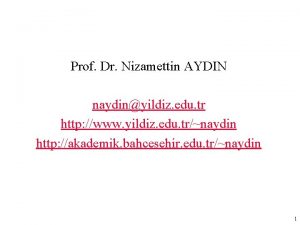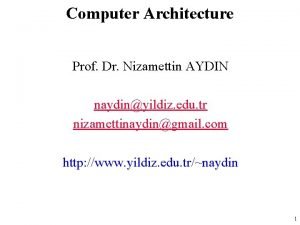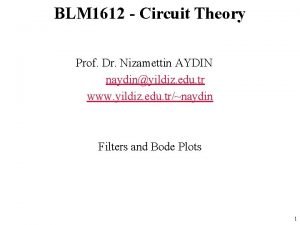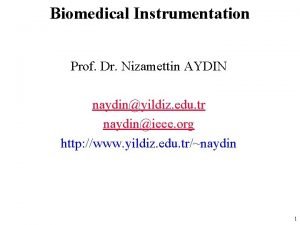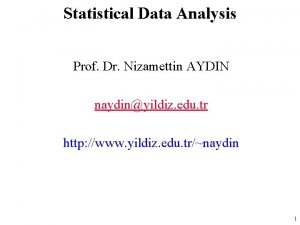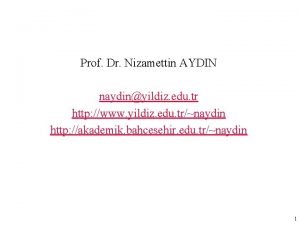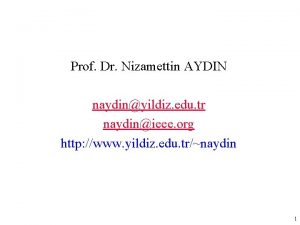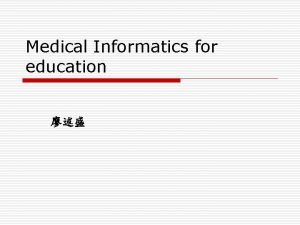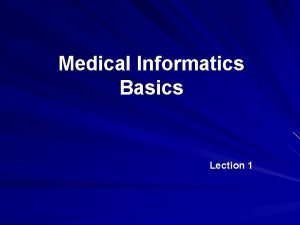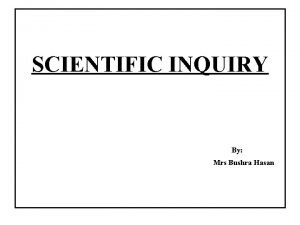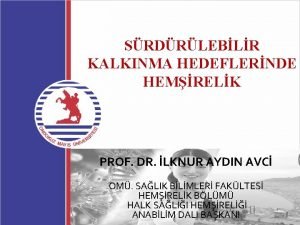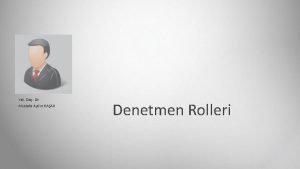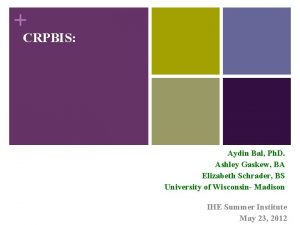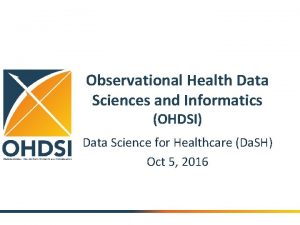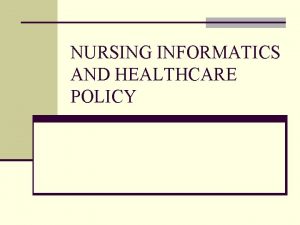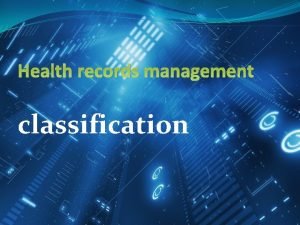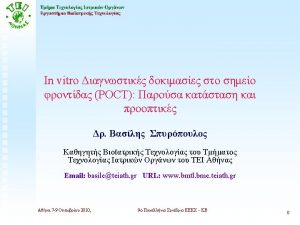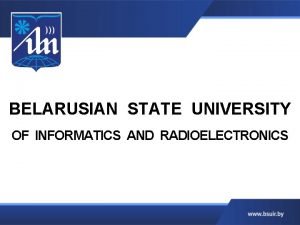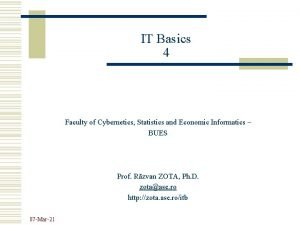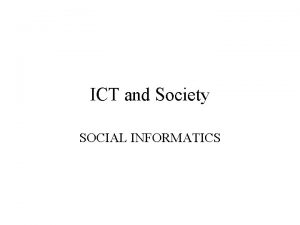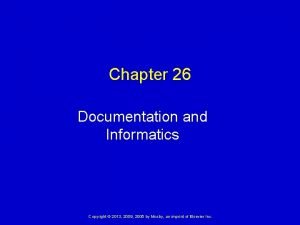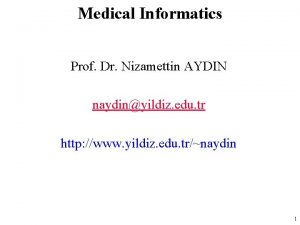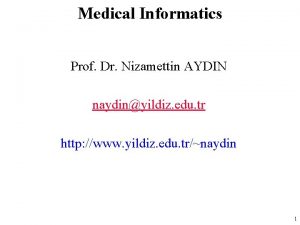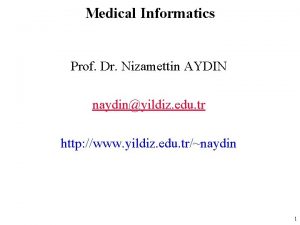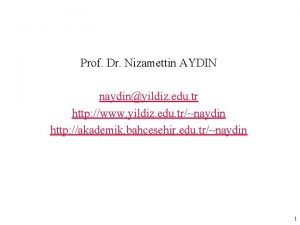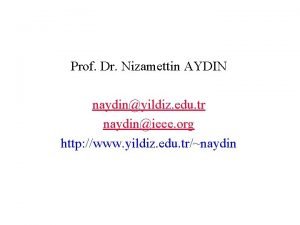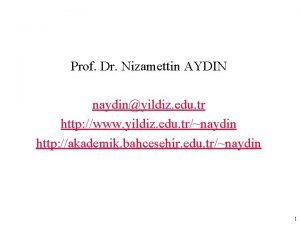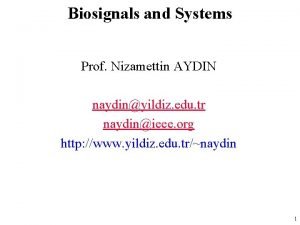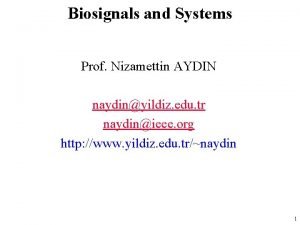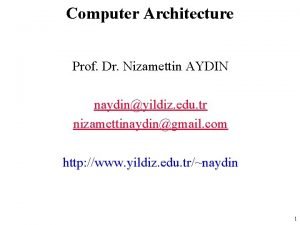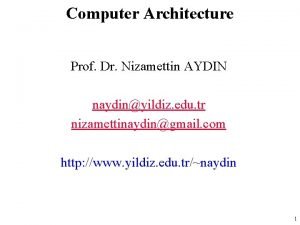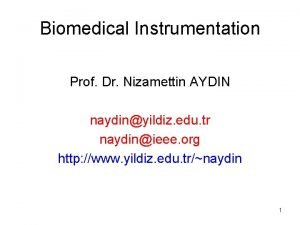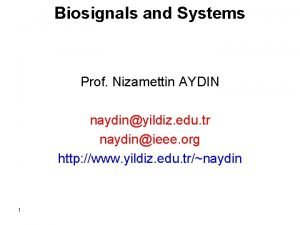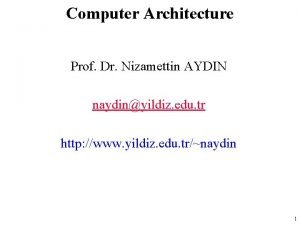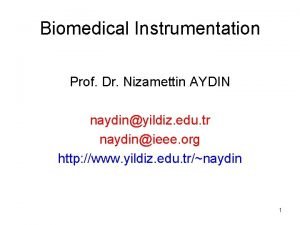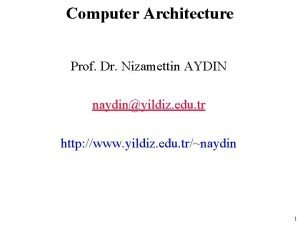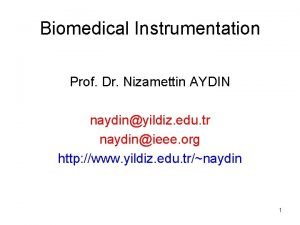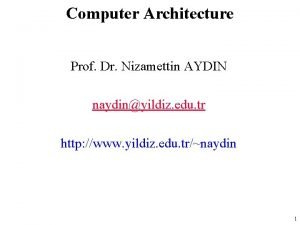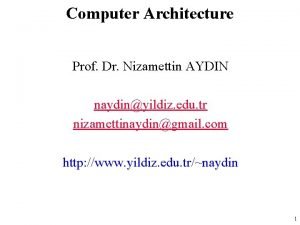Medical Informatics Prof Dr Nizamettin AYDIN naydinyildiz edu
















































- Slides: 48

Medical Informatics Prof. Dr. Nizamettin AYDIN naydin@yildiz. edu. tr http: //www. yildiz. edu. tr/~naydin 1

Standards and Medical Data Coding 2

Introduction • Standards are generally required when – excessive diversity creates inefficiencies or impedes effectiveness • In healthcare, standards are needed for – encoding data about the patient that are collected by one system and used by another. • One obvious need is the development of standardized identifiers for – individuals, healthcare providers, health plans, and employers • so that such individuals can be recognized across systems. 3

What are standards? • The formal definition by the ISO: – Standards are documented agreements containing technical specifications or other precise criteria to be used consistently as • rules, guidelines or definitions of characteristics, to ensure that • materials, products, process and services are fit for their purpose. 4

Types of specifications in standards • Standards can establish a wide range of specifications for products, processes and services (see www. iso. org for definitions) – Prescriptive specifications obligate product characteristics, • e. g. device dimensions, biomaterials, test or calibration procedures, as well as definitions of terms and terminologies. – Design specifications set out the specific design or technical characteristics of a product, • e. g. operating room facilities or medical gas systems. 5

Types of specifications in standards – Performance specifications ensure that a product meets a prescribed test, • e. g. Strength requirements, measurement accuracy, battery capacity, or maximum defibrillator energy. – Management specifications set out requirements for the processes and procedures companies put in place, • e. g. quality systems for manufacturing or environmental management systems. • A standard may contain a combination of specifications. – Prescriptive, design and performance specifications have been commonplace in standards. – Management specifications are also rapidly gaining prominence. 6

Types of specifications in standards • Recent years have seen the development and application of what are known as generic management system standards, where – generic means that the standards’ requirements can be applied to any organization, regardless of the product it makes or the service it delivers, – management system refers to what the organization does to manage its processes. 7

Types of specifications in standards • Two of the most widely known series of generic management system standards are – the ISO 9000 series for managing quality systems, – the ISO 14000 series for environmental management systems. • Information and assistance related to these standards and their application is available at – www. iso. org. • ISO 13485 and ISO 13488 are specific ISO quality systems standards for medical device manufacturing. 8

Why do we need standards? • Standards can: – Provide reference criteria that a product, process or service must meet. – Provide information that enhances safety, reliability and performance of products, processes and services. – Assure consumers about reliability or other characteristics of goods or services provided in the marketplace. – Give consumers more choice by allowing one firm’s products to be substituted for, or combined with, those of another. 9

Why do we need standards? • With the world becoming a global village, the need and benefits of standardization are becoming more and more important internationally for manufacturing, trade and communications. • Quality systems and other management standards can provide common references to the kind of process, service or management practice expected. – The Internet functions effectively because globally agreed-upon interconnection protocols exist. – Global communication would be very difficult without international standardization. 10

Why do we need standards? • Health care workers are well aware of incompatible consumables or replacement parts in medical devices of similar function that are made by different manufacturers. – The lack of available consumables and repair parts is an important cause of medical equipment problems that are constantly encountered in developing countries. • Most medical devices are used globally. • The safety, performance and consistent quality of medical devices is, therefore, an international public health interest. • Thus, global harmonization of medical device standards and regulations is critical. 11

Voluntary and mandatory standards • Most standards are voluntary. • A standard may be mandated by – a company, – professional society, – industry, – government, – trade agreement. • A standard may be called a regulation when it becomes mandatory. – This mandate may, or may not, have a legal basis. 12

Voluntary and mandatory standards • When a standard is mandated by a government or an international trade agreement, it normally becomes legally obligatory based on regulations or a law established by the government or the contracts between international bodies. • Countries that are considering making standards mandatory should take into account the potential consequences under international agreements on technical barriers to trade. 13

Standards development process • The figure provides an example of the many steps used by standards development organizations – see www. iso. org 14

Good standards have the following attributes • Their development has been overseen by a recognized body, – thus ensuring that the process is transparent and not dominated by vested interests. • The development process has been open to input from all interested parties and the resulting document based on consensus. – Consensus, in a practical sense, means that significant agreement among the stakeholders is reached in the preparation of the standard, including steps taken to resolve all objections. 15

Good standards have the following attributes • Good technical standards are based on consolidated results of science, technology and experience, and are aimed at the promotion of optimum community benefits. • Standards do not hinder innovations and must be periodically reviewed to remain in tune with technological advances. 16

Conformity assessment with standards • There are four common industrial methods for assessing conformity to a standard. – testing, certification, registration, accreditaion – A product’s conformity to standards is commonly assessed by direct testing. – A process can be assessed by audit. • Certification organizations or regulatory authorities attest that products or processes conform to a standard by authorizing the display of their certification mark. 17

Conformity assessment with standards – The conformity to management standard by an organization is known as management systems registration, a relatively new term used primarily in North America. • Formally established audit procedures are followed by certified auditors who are supported by technical experts of the domain under audit. Management System Registration bodies (Registrars) issue registration certificates to companies that meet a management standard such as ISO 9000, or to medical device manufacturers that meet the ISO 13485/ISO 9001 standards. 18

Conformity assessment with standards – Accreditation is used by an authoritative body to give formal recognition that an organization or a person is competent to carry out a specific task. • For example, in Europe, Notified Bodies are notified or accredited by the relevant State Competent Authority to carry out conformity assessment of medical devices. • In Canada, a Quality System Registrar needs an accreditation from Health Canada before that Registrar begins assessing medical device manufacturers for conformity with quality system standards. • The International Laboratory Accreditation Cooperation (ILAC) uses accreditation to provide formal recognition to competent laboratories around the world. 19

National and international standards systems • A country may have many voluntary standards bodies. • However, normally there is one official national organization that coordinates and accredits the standards development bodies in the country. • This official national organization would have the authority to endorse a document as a national standard in accordance with official criteria, and it also represents the country in the various international standards organizations. 20

National and international standards systems • In the USA, the American National Standards Institute (ANSI), – a private, non-profit organization, is an official national organization. • In Canada, the Standards Council of Canada (SCC), – a crown (government) corporation. • In Europe, a committee composed of CEN (Comité Européen de Normalisation), CENELEC (the European Committee for Electrotechnical Standardization) and ETSI (the European Telecommunication Standards Institute). • In Turkey, TSE (Türk Standartları Enstitüsü • https: //en. wikipedia. org/wiki/List_of_technical_standard_or ganisations 21

National and international standards systems • The three major international standardization organizations are – the International Electrotechnical Commission (IEC) • covers electrical and electronic engineering – the International Telecommunication Union (ITU) • covers telecommunications – the International Organization for Standardization (ISO) • covers the remainder. • For information technology, risk management, quality systems and many other areas, joint ISO/IEC technical committees manage standardization. 22

THE MAJORMEDICAL INFORMATICS CODING STANDARDS Ø Health Level 7 (HL 7) (http: //www. hl 7. org/ ) • the highest level of the ISO communication model. • It is a standard for data interchange. • The model’s purpose is to archive OSI (open systems interconnections), – a way to get different systems to work together. • The OSI model is not specific to medical informatics; however, HL 7 is specific to the healthcare domain. 23

THE MAJOR MEDICAL INFORMATICS CODING STANDARDS • Basic features of HL 7 (version 3) • https: //www. hl 7. org/documentcenter/public_temp_E 0 E 9812 A-1 C 23 -BA 170 C 4 C 0 A 0 EFF 5 B 2 B 3 D/standards/V 3/core_principles/infrastructure/coreprinciples/v 3 modelcorep rinciples. html – the object-oriented approach, – the definition of a RIM (Reference Information Model) in UML defining all messages, objects and their relationships, – the inclusion of specific conformance to the standard statements, and the use of XML (extensive markup language) as a structured communication language. 24

ISO/OSI Model in Communication Networks • There are n numbers of users who use computer network and are located over the world. • So to ensure, national and worldwide data communication, systems must be developed which are compatible to communicate with each other. • ISO has developed this. This is called a model for Open System Interconnection (OSI) and is commonly known as OSI model. • The ISO-OSI model is a seven layer architecture. • It defines seven layers or levels in a complete communication system. • • http: //www. studytonight. com/computer-networks/completeosi-model https: //en. wikipedia. org/wiki/OSI_model 25

THE MAJOR MEDICAL INFORMATICS CODING STANDARDS • The use of the XML and the RIM has enabled the exchange of medical data among different healthcare organizations and devices and consequently the development of distributed networked e-health applications. • For instance external systems with XML-aware browsers can communicate with a hospital information system (HIS) through the HL 7 standard. 26

THE MAJOR MEDICAL INFORMATICS CODING STANDARDS • The structure of an HL 7 message is as follows: – Each message is constituted by specific segments in a concrete line. – Each message has a message type that determines his scope. – Each type of message corresponds in one or more actual incidents (trigger event). • Actual incidents can be, for example, a patient admission or a medical examination order. – Each segment has specific data fields. 27

THE MAJOR MEDICAL INFORMATICS CODING STANDARDS – Segments in an HL 7 message are either mandatory or optional while it is possible they are repeated in a message. – Each segment has a concrete name. • For example a message related to patient admission discharge and transfer functions (Type: ADT) can include the following segments: – – Message Header (MSH), Event Type (EVN), Patient ID (PID), and Patient Visit (PV 1) 28

THE MAJOR MEDICAL INFORMATICS CODING STANDARDS • A message example: • MSH|ADT 1|MCM|LABADT|MCM|199808181126|SECURITY|A DT∧A 01|MSG 00001|P|3. 0| • EVN|A 01|199808181123|| • PID|||PATID 1234∧ 5∧M 11||JONES∧WILLIAM∧A∧III||1961 0615|M||C|1200 N ELM STREET∧∧GREENSBORO∧NC∧ 27401 -1020|GL|(919)379 1212|(919)271434||S||PATID 12345001∧ 2∧M 10|123456789| 987654∧NC| • NK 1|JONES∧BARBARA∧K|WIFE||||||NK∧NEXT OF KIN • PV 1|1|I|2000∧ 2012∧ 01||||004777∧LEBAUER∧SIDNEY∧J. |||SUR|||| ADM| A 0| 29

THE MAJOR MEDICAL INFORMATICS CODING STANDARDS • The message explanation is as follows: • Patient William A. Jones, III was admitted for surgery (SUR) on 18 th July 1998, 11. 23 p. m. from the doctor Sidney J. Lebauer (# 004777). He entered the surgical room 2012, bed 01 in the nursing unit 2000. This message was sent by the system ADT 1 to the system LABADT, 3 minutes afterward admission. 30

THE MAJOR MEDICAL INFORMATICS CODING STANDARDS Ø International Classification of Diseases (ICD) • a specific standard for medical terminologies. – first published in 1893 and has been revised at roughly every 10 year (by the WHO). – The tenth edition was published in 1992. • The coding consists of a core classification of three digits. • A fourth digit (the decimal) is used for further detail • The terms are arranged in a hierarchy based on the digits. 31

THE MAJOR MEDICAL INFORMATICS CODING STANDARDS • The ICD has become the international standard diagnostic classification for all general epidemiological and many health management purposes including; – the analysis of the general health situation of population groups, – monitoring of the incidence and prevalence of diseases, – other health problems in relation to other variables such as the characteristics and circumstances of the individuals affected. 32

THE MAJOR MEDICAL INFORMATICS CODING STANDARDS • It is used to classify diseases and other health problems recorded on many types of health and vital records including death certificates and hospital records. • In addition to enabling the storage and retrieval of diagnostic information for clinical and epidemiological purposes, these records also provide the basis for the compilation of national mortality and morbidity statistics by WHO member states. 33

THE MAJOR MEDICAL INFORMATICS CODING STANDARDS • ICD-10 is the 10 th revision of the ICD • ICD-10 uses alphanumeric codes, with an alphabetic character in the first position. • ICD is incorporated in most of electronic health record (EHR) implementations; • It is quite powerful tool for the development of integrated distributed health records, – concentrating the total medical history of a patient. • http: //apps. who. int/classifications/icd 10/browse/2010/en • http: //www. icd 10 data. com/ 34

THE MAJOR MEDICAL INFORMATICS CODING STANDARDS • An Example of an ICD-10 Classification Table 35

THE MAJOR MEDICAL INFORMATICS CODING STANDARDS Ø Digital Imaging and Communications in Medicine (DICOM) (http: //dicom. nema. org/ ) • a standard for exchanging medical images. – Medical images comply with the DICOM format. • A single DICOM file contains both – a header • which stores information about the patient’s name, the type of scan, image dimensions, etc. – and all of the image data. 36

THE MAJOR MEDICAL INFORMATICS CODING STANDARDS • The header contains information regarding – its size, – the size of the whole image, – and usually information that has to do with the image type and characteristics • resolution, • possible compression, • number of frames, etc • Following slide shows a DICOMcompliant image file representation, where after the header section the image data follow. 37

THE MAJOR MEDICAL INFORMATICS CODING STANDARDS • DICOM Compliant Image File Format Representation 38

THE MAJOR MEDICAL INFORMATICS CODING STANDARDS • The standard also specifies the following: – A set of protocols for devices communicating over a network. – The syntax and semantics of commands and associated information that can be exchanged using these protocols. – A set of media storage services and devices claiming conformance to the standard • The DICOM standard is used in almost all e-health applications handling medical images – picture-archiving and communicating systems, PACS, and telemedicine and teleradiology 39

BIOSIGNAL CODING STANDARDS • Biosignals in networked e-health applications are provided in numerical format – i. e. , heart rate, respiratory rate, temperature of body, arterial blood pressure, etc. and as waveforms – i. e. , ECG, EEG, etc). • Numerical data are very easy to handle and code in applications. • Regarding the waveforms; – the acquisition and transmission of ECG is the most usual technique for the determination and the verification of a patient’s condition in a remote position. 40

BIOSIGNAL CODING STANDARDS • Almost all modern ECG are equipped with digital outputs and use digital techniques for communication. • The computer-based coding and communication of ECG is regulated by the Standard Communications Protocol, SCP-ECG. • SCP-ECG is a file format for ECG traces, annotations, and metadata. • It is defined in the joint ANSI/AAMI standard EC 71: 2001 and in the CEN standard EN 1064: 2005. 41

SCP-ECG Standard Description • The ECG data are divided into different sections. – See http: //www 3. openecg. net/ • A global overview of the SCP-ECG data structure 42

SCP-ECG Standard Description • In the SCP standard each section is divided into two parts: – the section ID Header – the section Data Part • Although the section ID Header always has a length of 16 bytes, the section data part is variable. • SCP-ECG Data Fields in SCP standards are illustrated in the following slides 43

SCP-ECGStandard Description • SCP-ECG Data Fields 44

SCP-ECG Standard Description 45

SCP-ECG Standard Description 46

SCP-ECG Standard Description • Overview of the data part holding the extended ECG data – https: //www. hindawi. com/journals/ijta/2010/137201/ 47

SCP-ECG Standard Description • The SCP standard allows for a rather large number of options to store and format the ECG data. • ECG data may be – acquired at different sampling rates, with different quantization levels – not compressed or be compressed by selectable methods • An SCP-ECG record may or may not contain analysis and over reading results. • Also, the number of leads, the length of the recording interval and even the simultaneity of leads is left open to the manufacturers. 48
 Prof. dr. nizamettin aydin
Prof. dr. nizamettin aydin Nizamettin aydin
Nizamettin aydin Prof. dr. nizamettin aydin
Prof. dr. nizamettin aydin Prof. dr. nizamettin aydin
Prof. dr. nizamettin aydin Nizamettin aydin
Nizamettin aydin Package diagram
Package diagram Mega giga tera
Mega giga tera Introduction to medical informatics
Introduction to medical informatics Medical informatics definition
Medical informatics definition Journal of american medical informatics association
Journal of american medical informatics association Sinan aydın ymm
Sinan aydın ymm Aydın kendirci
Aydın kendirci Thede loder
Thede loder Sevil aydın
Sevil aydın Aydın bir türk kadınıyım
Aydın bir türk kadınıyım Xahra franklin
Xahra franklin Ilknur aydın avcı
Ilknur aydın avcı Aydin marine
Aydin marine Aydın başar
Aydın başar Nazmi aydın
Nazmi aydın Aydin bal
Aydin bal Aydın kekemelik merkezi
Aydın kekemelik merkezi Edu.sharif.edu
Edu.sharif.edu Scca intranet
Scca intranet Observational health data sciences and informatics
Observational health data sciences and informatics Nursing informatics and healthcare policy
Nursing informatics and healthcare policy Emily navarro uci
Emily navarro uci Informatics 43 uci
Informatics 43 uci Supply chain informatics
Supply chain informatics Python for informatics: exploring information
Python for informatics: exploring information Metastructures of nursing informatics
Metastructures of nursing informatics Supply chain informatics
Supply chain informatics Python for informatics
Python for informatics Python for informatics: exploring information
Python for informatics: exploring information Python for informatics
Python for informatics Health informatics
Health informatics Poc informatics
Poc informatics Nursing informatics theories, models and frameworks
Nursing informatics theories, models and frameworks Belarusian university of informatics and radioelectronics
Belarusian university of informatics and radioelectronics Python for informatics
Python for informatics What is pharmacy
What is pharmacy Faculty of cybernetics statistics and economic informatics
Faculty of cybernetics statistics and economic informatics How to disconnect from society
How to disconnect from society Chapter 26 documentation and informatics
Chapter 26 documentation and informatics Chapter 2 career skills in health informatics
Chapter 2 career skills in health informatics History of pharmacy informatics
History of pharmacy informatics History of pharmacy informatics
History of pharmacy informatics Biomedical informatics definition
Biomedical informatics definition Va office of health informatics
Va office of health informatics
